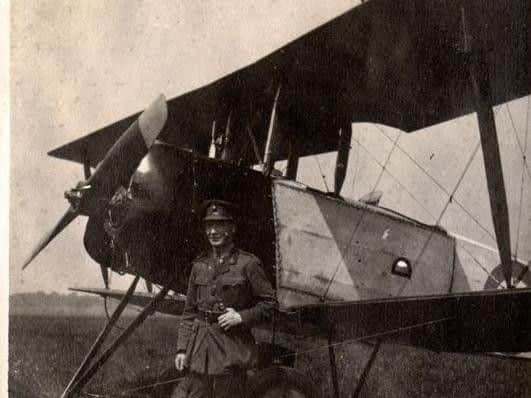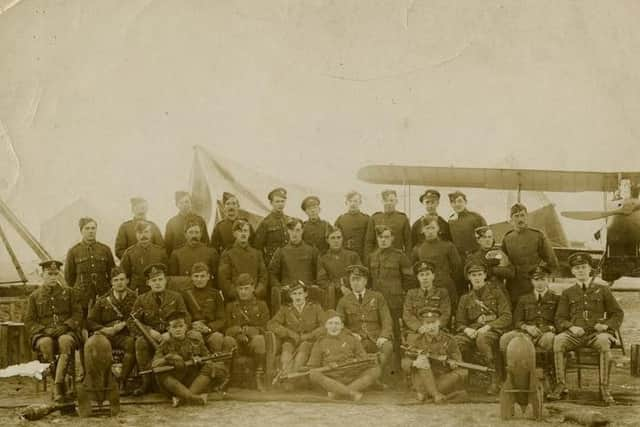Doncaster's pioneering role in World War One air warfare revealed


The world’s first fighter pilots trained in South Yorkshire and cutting-edge technology was developed in a terrifying international arms race against enemy ‘Baby Killers’ – the deadly Zeppelin airships whose terrible toll on Sheffield is described on P6-7.
The exhibition, Riding High: Doncaster Airfields and the Zeppelin Raid on Sheffield, is a partnership between the South Yorkshire Aircraft Museum and Doncaster 1914-18, a four-year project supported by National Lottery players through the Heritage Lottery Fund (HLF), commemorating the centenary of the First World War.
Advertisement
Hide AdAdvertisement
Hide AdIt traces the near-forgotten 100-year-old origins of modern air warfare in the area, through personal letters and photographs, original remnants from serving aircraft – some lovingly recycled into souvenirs by their owners – and scale models.


“At the outbreak of the First World War, aviation was in its infancy, having only been developed over the previous decade,” said Jude Holland, Doncaster 1914-18 project manager.
“In the run-up to the war, aeroplanes were a novelty – little more than pleasure craft – and people would never have dreamed of flying to war.
“Zeppelins changed that: they were a horrifying innovation that sent a shockwave of fear across Britain, and were dubbed Baby Killers”.
For the first time, the skies became a battleground.


Advertisement
Hide AdAdvertisement
Hide AdJude said: “Aeroplanes were also transformed into weapons of war and the country was catapulted into a deadly battle for the skies, with South Yorkshire right at the heart of it all.”
South Yorkshire was perfectly placed to make an impact – local businessmen had already spotted the potential to make money from new aviation technology, launching Britain’s first-ever airshow in 1909 at Doncaster Racecourse, and attracting the best pilots .
Some of these – like Harold Blackburn of Doncaster – would later become Britain’s first wartime pilots.
Sheffield was also one of the UK’s most important industrial cities so, not surprisingly, the area soon became a regional hub in the battle for the skies.


Advertisement
Hide AdAdvertisement
Hide AdAction included training hundreds of pilots assembling and repairing aircraft, and acting as a local base for the newly-formed Royal Flying Corps, later to become the Royal Air Force.
As a result, South Yorkshire experienced the astonishing growth of aviation, gaining five new airfields and a specialist factory during the war.
Businesses like Peglers of Doncaster also adapted to work with aircraft, many employing large numbers of women for the first time.
In 1914, the RFC had 63 aircraft and 900 men – in 1918, this had rocketed to 22,000 aircraft, with more than 122,000 men and women serving worldwide.


Advertisement
Hide AdAdvertisement
Hide AdUnfortunately, the need was especially high because of the heavy casualties and loss of life, as South Yorkshire Aircraft museum volunteer Ian Kingsnorth discovered.
He has spent hundreds of hours researching and curating the exhibition, alongside fellow volunteers Mike Jackson and Bill Fern.
Ian said: “Over 8,000 air-related casualties are recorded between 1916 and 1918, so training grounds like Doncaster, had to produce thousands of pilots during the course of the war.
“People were also working with near-experimental technology – it was hazardous and unstable.
Advertisement
Hide AdAdvertisement
Hide Ad“What really strikes you time and again is the enormous bravery of these local people, who knew the risk to their lives, but still carried on fighting.
“It’s so easy to get lost in the broad sweep of history and forget about the real people involved – people like you and me. As you start to uncover these local stories, it brings it all so much closer to home.”
The volunteers have been especially touched by the story, rediscovered during the project, of Hugh Carson from Balby in Doncaster, who enlisted in the RFC in 1916.
Hugh’s family were kind enough to loan original objects to the exhibition, including letters to his wife and daughter which expose the personal toil war took on the area’s flying pioneers.
Advertisement
Hide AdAdvertisement
Hide AdA notebook with intricate sketches of planes revealed not only his technical skill but the heavy demands of keeping a flight of up to six bombers ready to fight on the Western Front every day.
Alan Beattie, chairman of South Yorkshire Aircraft Museum, said: “This exhibition is a tribute to the courageous men and women of South Yorkshire who made sure that Britain won the battle for the skies during the First World War.
“Riding High shows how the legacy of local heroes like ‘Ace’ Lesley Peach Aizlewood, a Rotherham lad and Sheffield University student who won the Military Cross, is still shaping our lives today.
“South Yorkshire’s people made a tremendous contribution to the war and it’s wonderful to be uncovering their stories at last, and making sure their memories aren’t lost forever.”
Advertisement
Hide AdAdvertisement
Hide AdThe museum is located at Dakota Way, Doncaster, DN4 7NW. For opening times and admission prices, visit www.southyorkshireaircraftmuseum.org.uk. To find out more about getting involved in Doncaster 1914-18, visit www.doncaster1914-18.org.uk